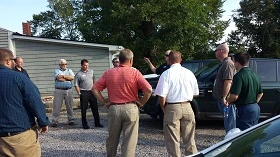
With the economy continuing to improve, the amount of companies being bought and sold will surely heat up. Two companies who have incorporated mergers as a growth strategy were part of Jim Huston’s brainstorming session, “Going M.A.D.” in Raleigh, N.C.
Brian DuMont, owner of Yard-Nique based in Raleigh, N.C., and Brian Lemmermann, owner of Somerset Landscape based in Phoenix, talked about how they’ve approached mergers in recent years.
Yard-Nique has seven locations across the Southeast U.S. and revenues approaching $25 million. Three of those seven locations were acquired, with two happening in the past 16 months. Somerset has grown from almost $7 million in 2011 to $35 million this year. Lemmermann’s acquired 10 companies since 2011 and currently has offices in California, New Mexico, Texas, Utah and Nevada, along with the Arizona office.
Here’s a look into how both view the acquisition process.
Know what you want. DuMont is usually looking at 2-3 companies at a time. He is open-minded about deals, but always has a strong idea about what he is looking for in a company. Whether it’s a strong culture, the equipment or the book of business, you should have clear priorities, he says.
Spread the word. DuMont and Lemmermann both will send word out with people they meet in the industry, stating they are in acquisition mode. DuMont will also task branch managers with bringing back three possible companies that fill Yard-Nique’s requirements. If DuMont can’t pay off an acquisition in two to four years, he won’t pursue a purchase.
Help and hurt. When it comes to brokers, DuMont says:
• A good broker is worth every penny.
• Bad brokers can break up a deal
• When not using a broker, things can get emotional and expectations and demands can become unrealistic.
No wholesale changes. When he is in discussion with an owner about buying a company, he is clear he doesn’t want to buy it and then completely erase what the owner has done. He says when he lays out this plan, the owner is more inclined to sell and at a better price because DuMont values the history of the company. “The owners care about what they built,” he says.
Curious visitor. As far as visiting a company to evaluate it, Lemmermann and DuMont leave it up to the owner of the company on how Lemmermann and DuMont’s presence will be explained. For example, one owner introduced Lemmermann as the owner’s friend from Phoenix who wanted to check out his company.
After the sale. DuMont says he has handled post-acquisition incorporation both ways. He’s changed the name and leadership of an acquired company and rebranded the company as Yard-Nique, and he’s left a company’s brand alone. It all depends on how strong the brand is and how much he likes the leaders. Both Lemmermann and DuMont say they have learned a lot of new systems and practices from companies they’ve acquired. They both said you have to be humble and can’t come in right away and start implementing your systems when the company you’re acquiring may have better ones in place.
The first visit. When first visiting the site of a company he’s acquired, Lemmermann doesn’t want to “come in and make a splash.” The first action he takes is getting the buy-in from the lower and middle levels of the organization. The worst case scenario for Lemmermann is a manager who wants to start his own company and take the crews with him. If he can get immediate buy-in from the crews, he has a better chance of avoiding that situation. The first weekend after he acquired a company in Las Vegas, he spent time with the employees below the supervisor/managerial level in the office and in the field.
“We come in really softly,” Lemmermann says. “We start with easy suggestions that can help operations, but we are taking just as many positive systems back to the parent company.”
DuMont approaches the first post-acquisition meeting by telling employees he admires what they’ve built and he has no plans to make wholesale changes. Yard-Nique also likes to start a newly-acquired company with a win like purchasing new mowers or painting some trucks that looked bad.
Organic growth. While acquiring companies is a great way to grow, it shouldn’t be the only way you increase your revenue, Lemmermann says. “If you aren't able to grow organically, any acquisition can quickly become a liability and put your entire organization in jeopardy,” he says. “Acquisitions can be dangerous and are only a piece of a strong growth plan.”
L&L also visited two of Yard-Nique’s offices in the Raleigh, N.C.-area, including the corporate headquarters. Here’s what we learned.
Onsite fueling. Workers fill up in the morning and fill up every truck and machine before leaving. This avoids crew making any stops for fuel during their routes.
Assigned parking. Crews have assigned parking spots for trucks, which makes morning roll-out less chaotic. Every project manager has a pod to store equipment like blowers and excess materials near his crews’ parking spots. Each project manager averages about three crews.
Breaking news. Every office has a Y&N newsboard where news about employees can be posted. This is a place where the company can share good news about the company and individual employees. The information is collected and posted by the branch manager.
Ahead of the rest. A construction member can earn a Y/N sticker on his hard hat for going above and beyond. The stickers are a public way the company can acknowledge workers who have gone above and beyond. The company also gives out awards, like a new pair of safety glasses, for workers who have been excelling on the job. This replacement policy is no additional cost to the employee for as long as they are employed.
Dressed for success. The company makes all new laborers buy five uniform shirts as a way to show the worker is committed to Yard-Nique. The shirts cost about $5 and can be deducted from paychecks. Once the shirt becomes worn out the laborer can trade in the shirt for a new one at no cost.
Looking good. The company is still in the process of painting 100 trucks in the past year and a half with the new company color (orange) and new company logo. “I wanted to set us apart from the typical brown and green,” DuMont says.
House ain’t a home. The company’s main headquarters is spread out between three houses built in 1865, 1901 and 1920. The houses were considered uninhabitable, and DuMont bought them and rehabbed them.
Organized from the start. The company hired a human resources director, Kelly Somers, two years ago, and among the many ways the hire has improved the company is the onboarding process that was installed after Somers joined. When a new employee starts, they are set up with everything they need on the first day. Whether it’s new uniforms, a new truck or a laptop, the items are ready for use on the worker’s first day. The company has not yet measured if this has had a direct ROI, but COO Ryan Wells has heard from new employees how much they appreciate the organized process.
Latest from Lawn & Landscape
- EnP Investments adds Mark McCarel as Northeast territory sales manager
- Our April issue is now live
- Ready or not
- Tribute to an industry guru
- Caterpillar names Christy Pambianchi as chief human resources officer
- Ceramica acquires Fundraising Brick
- Senske Family of Companies acquires Huron Pest Control
- Sunseeker unveils new X7 Series Robotic Mowers





